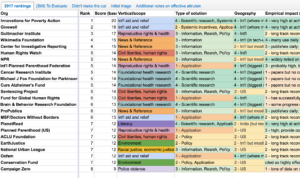If you’ve read my past charity evaluations, you’ve seen that Innovations for Poverty Action has rated at or near the top of my rec lists for effective charities.  They perform scientific research on how to effectively help large numbers of people out of poverty, and into healthier, happier, lives.  They focus on identifying high impact, scalable solutions.  Their results impact policies and actions worldwide.
IPA just shared in the Washington Post some of the brighter spots from their last year of research, as well as some takeaways for future giving, in an article entitled, Why 2016 was actually one of the best years on record.  I’m quoting it very extensively here so I can add my own bolding, but it’s worth clicking through and reading the whole thing, particularly if you’re interested in more relevant studies and details:
Between 1990 and 2013 (the last year for which there is good data), the number of people living in extreme poverty dropped by more than half, from 1.85 billion to 770 million. As the University of Oxford’s Max Roser recently put it, the top headline every day for the past two decades should have been: “Number of people in extreme poverty fell by 130,000 since yesterday.†At the same time, child mortality has dropped by nearly half, while literacy, vaccinations and the number of people living in democracy have all increased.
….Here are four things we’ve learned in 2016:
First, give the poor cash. Studies in Kenya and elsewhere show that the simplest way to help is also quite effective…. More and more research shows that when the poor come into a windfall, they spend it on productive things — sending their children to school, fixing the roof that’s letting in the harsh weather or investing in a business….
Second, innovative health-care delivery can dramatically improve outcomes…. [In Uganda, NGOs have tried training women who do Avon-style door-to-door sales to also] perform basic health checks for children to look for symptoms that warrant getting the child to a clinic. One randomized evaluation released this year concluded that taking this health care to people’s homes reduced child mortality (for those younger than 5) by an astounding 27 percent and infant mortality (less than a year old) by 33 percent.
Third, access to mobile money may lift people out of poverty in large numbers.…. Research from this year shows that as [Kenya mobile money system] M-Pesa became more available in a local area, households became less poor — particularly households run by women. The study estimates that 185,000 women changed professions from subsistence agriculture to business and retail and that 194,000 households were lifted out of extreme poverty.
Finally, mobile phone technologies are leapfrogging the reach of traditional telecom infrastructure, and text message reminders are proving to be effective at helping people follow through on things they want to do. One study found that they helped the poor save money. [Others found they can help patients finish taking antimalarial drugs, help educate girls about reproductive health, and reduce student dropout rate.]
The size of the impacts in the cited studies are very impressive, as are the overall numbers for the past ~2 decades.  (It’s a bit silly for the headline to imply that 2016 is one of the best years on record in terms of poverty reduction, though, given that we won’t be able to get good data for a bit — but these are definitely some great research results that will presumably steepen the decline of poverty going forward.)  I’m also encouraged, as someone who hears a lot of well-intentioned suggestions from the tech sector about how tech can take on problems like poverty, to hear that some mobile solutions are actually substantially effective in this problem space.

